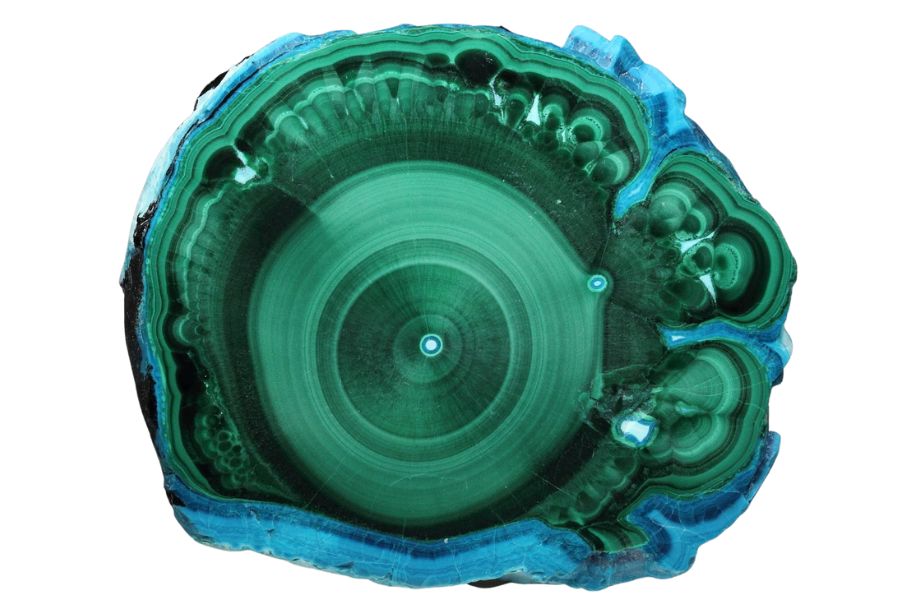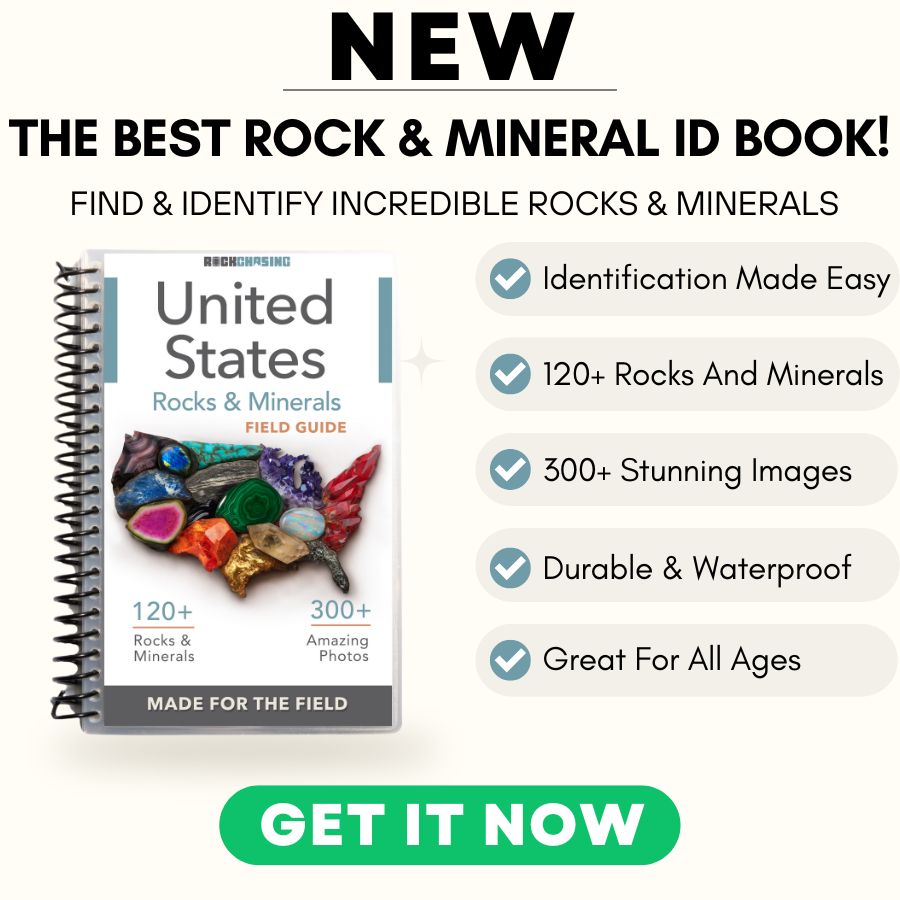Oregon is full of interesting rocks, minerals, and gems. If you’re thinking of dull, gray stones, you’re wrong! The rocks and minerals in the state are very different in color and structure. Every new find is a reminder of how amazing nature is as an artist.
It’s a great place for people exploring and collecting rocks and minerals. Every area has something different to offer, from the hot deserts to the foggy coasts.
The best part? You don’t need to be good to begin with. If you’re interested and like to try new things, you can start your own collection of these unique natural treasures.
We’re going to talk about the different rocks, gems, and minerals that you can find in Oregon. We’ll even give you some ideas of where you can go to find them!
The Common Rocks, Stones, and Minerals Found Here
These rocks and gems are some of the most famous in the state. Click on the links below to read the full guides, which are very in-depth:
The State Rock, Mineral, and Gem
This is a list of Oregon’s official state treasures.
| Oregon State Rock | Thunderegg |
| Oregon State Mineral | Oregonite |
| Oregon State Gem | Oregon Sunstone |
Visit the website of the Oregon Department of Geology and Mineral Industries to find out more about the state’s geology policy.
Always Confirm Access and Collection Rules!
Before heading out to any of the locations on our list you need to confirm access requirements and collection rules for both public and private locations directly with the location. We haven’t personally verified every location and the access requirements and collection rules often change without notice.
Many of the locations we mention will not allow collecting but are still great places for those who love to find beautiful rocks and minerals in the wild without keeping them. We also can’t guarantee you will find anything in these locations since they are constantly changing.
Always get updated information directly from the source ahead of time to ensure responsible rockhounding. If you want even more current options it’s always a good idea to contact local rock and mineral clubs and groups
Chalcopyrite
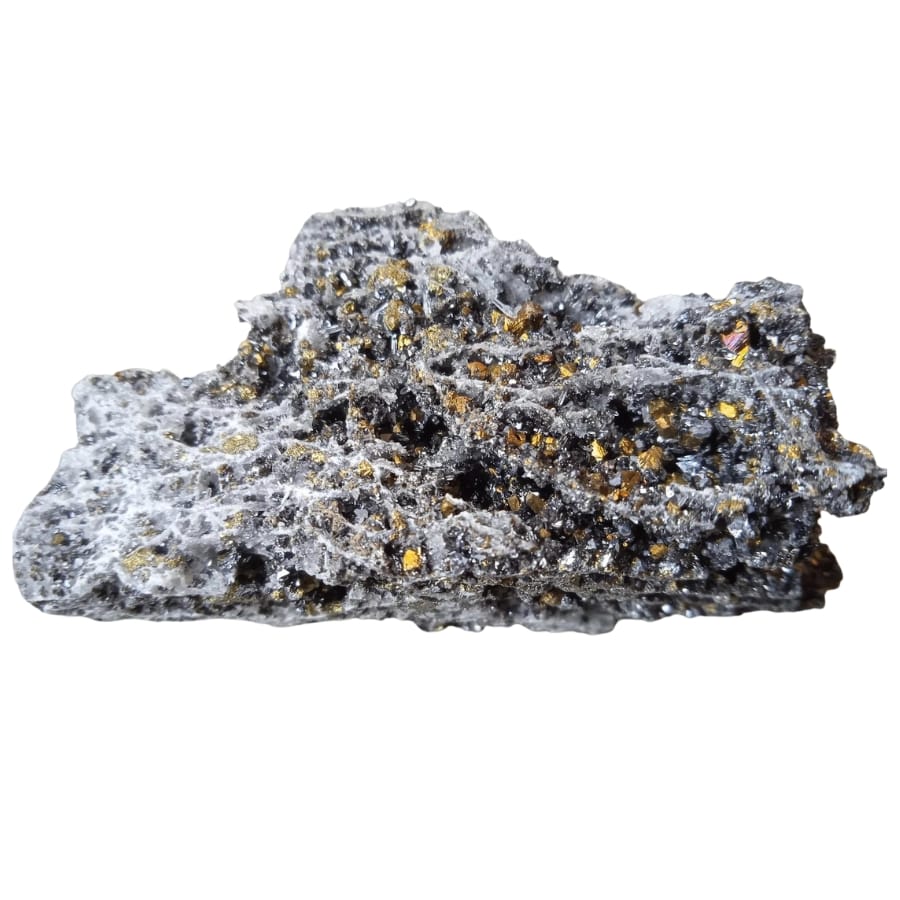
Not many people have heard of chalcopyrite, but it’s a very interesting material that is important to many things. It’s made up of copper, iron, and sulfur, which is what a copper iron sulfide ore means.
Its name comes from the Greek words “chalkos” and “pyrites.” ‘Chalkos’ means copper, and ‘pyrites’ means to start a fire. This name makes sense since chalcopyrite is made of copper and can spark metal when it comes in contact with it.
This mineral forms deep in the ground where cracks in the earth let hot fluids pour out. There are many different elements in these fluids. It can form crystals in rocks like dolomite and limestone or in layers with other minerals when they cool down.
Several things make chalcopyrite valuable. It’s a significant source of copper, which is the main reason. Copper is used for many things, like making coins and electrical lines.
It’s very helpful since it doesn’t rust and transports electricity well. Because it looks like metal and is shiny, chalcopyrite is also sometimes used as a decoration stone.
Where you can find Chalcopyrite in Oregon
In the state, you can find chalcopyrite in the following places:
- Crackerjack Mine
- Jump-Off Joe Creek
Chrysocolla
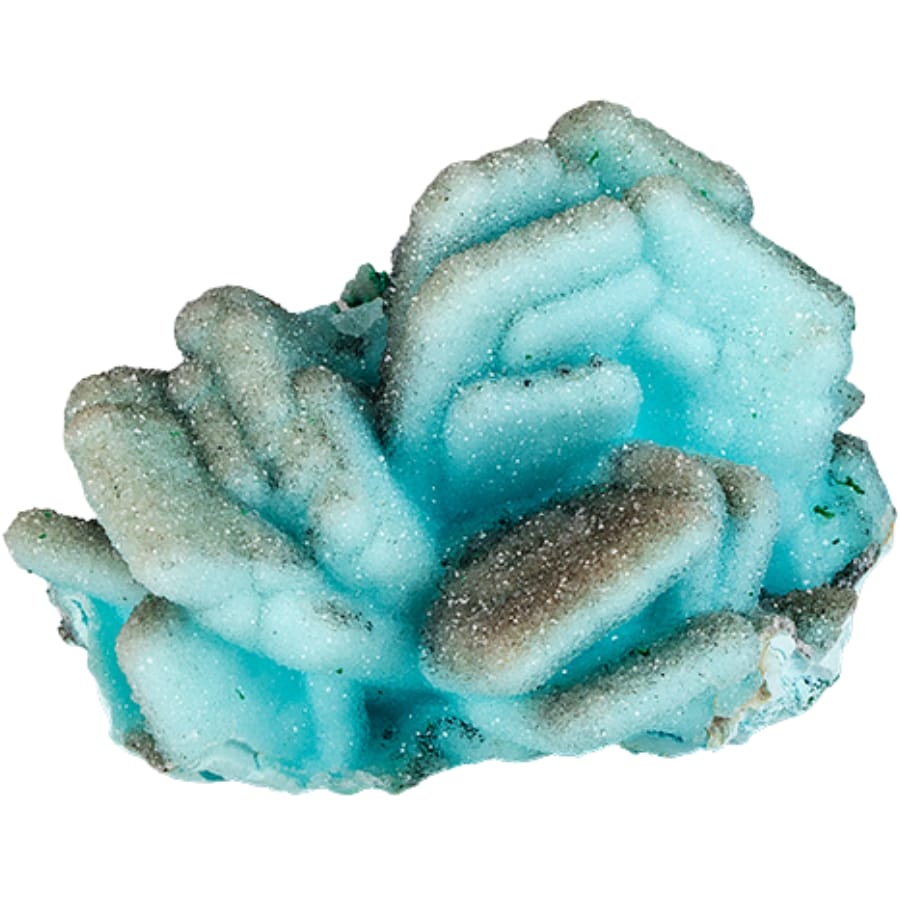
Amazing blue and green colors make chrysocolla a very cool and pretty gem. In addition to copper, this material also has hydrogen, oxygen, and silicon in it. Chrysocolla is often found with quartz and other rocks, which can make it look even more exquisite.
It comes from the Greek words “chrysos,” which means gold, and “kolla,” which means glue. Crystalline chrysocolla was once used to join gold pieces together and give it its name.
This mineral forms on top of copper ore sources. It’s usually found in places with a lot of other copper minerals.
Beyond its beauty, it’s valued for its historical value and jewelry use. Jewelry makers love to use it to make necklaces, earrings, and other decorative items because of its bright colors and designs.
Where you can find Chrysocolla in Oregon
Chrysocolla can be found in the state in the following places:
- Illinois River
- Jump-Off Joe Creek
Obsidian
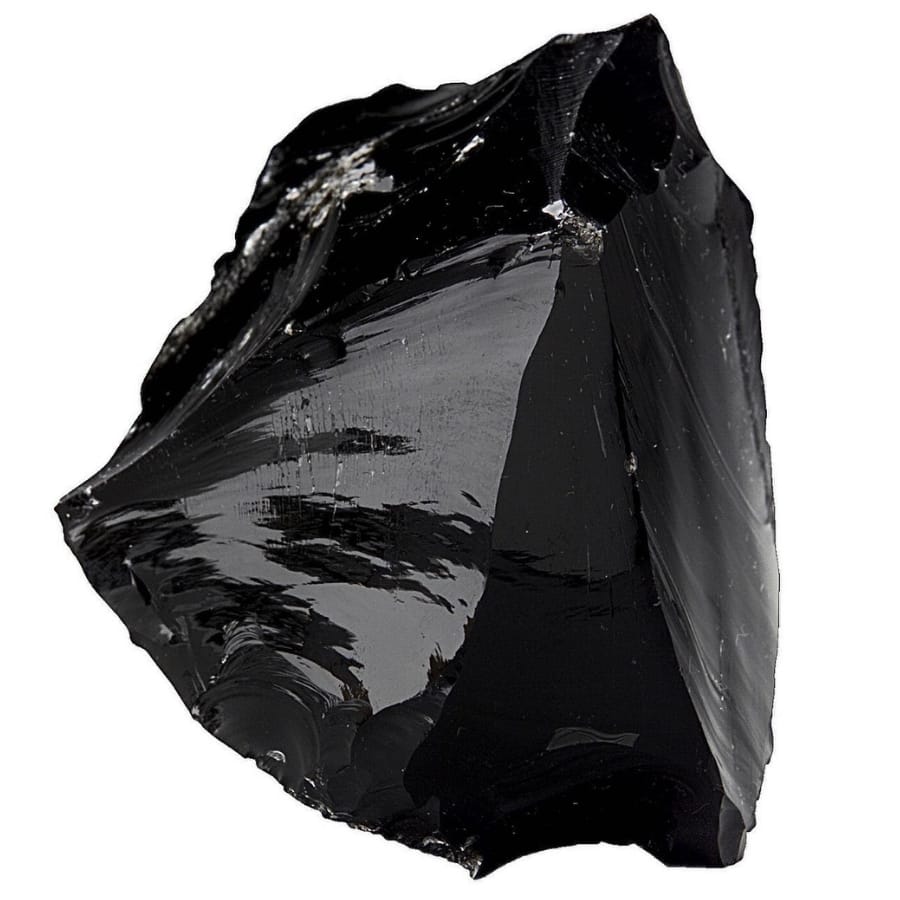
Obsidian is an exciting rock that looks like glass. That stuff is volcanic glass, made when ash from a volcano cools down quickly. When lava cools quickly, it doesn’t have time to turn into crystals.
Instead, it turns into this smooth, shiny glass. It’s usually black but occasionally has brown, green, or even a rainbow-like sheen. This is because of tiny air or mineral bubbles that get stuck inside.
“Obsidian” comes from a Roman named Obsius, who is said to have found a stone that looked a lot like it in Ethiopia. One cool thing about this mineral is that it can be very sharp when it breaks. Even the best steel blades can’t always match its sharp edges.
Obsidian is valuable for many reasons. Because of this, it was used to make tools and weapons like arrowheads, spears, and knives. Even though it isn’t used as much for tools and weapons these days, it’s still a useful rock.
Where you can find Obsidian in Oregon
Here is where you can find obsidian in the state:
- Glass Butte Recreational Rockhound Area
- Klamath Falls
Here is a great video showing where and how to find Obsidian in Glass Butte
Sphalerite
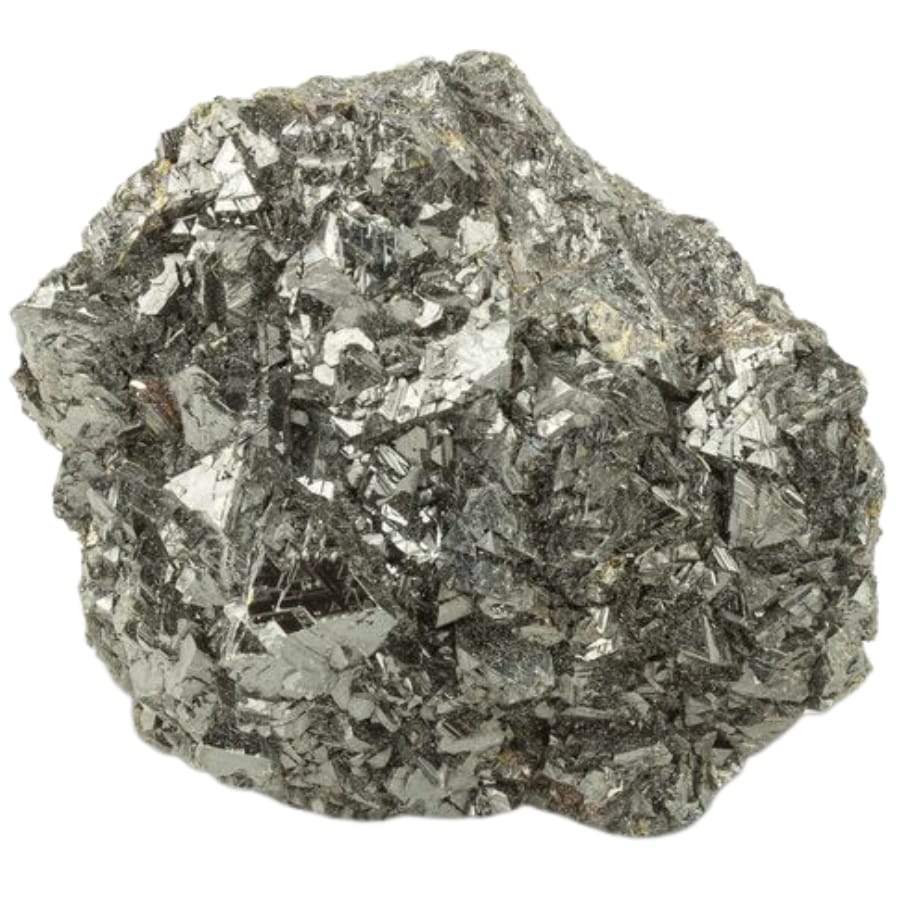
Sphalerite is an interesting mineral that is mostly made up of sulfur and zinc. You can get it in yellow, brown, red, green, and even black. This gives it a unique look.
The shiny, sparkly surface is what makes it stand out. When the light hits it just right, it can look a bit like a diamond. The name for this shiny look is “adamantine luster.” There is a good chance that you will find sphalerite near galena, pyrite, and calcite.
The word “sphalerite” comes from the Greek word “sphaleros,” which means dishonest or sneaky. This name was chosen because sphalerite comes in many colors and is often found mixed with other minerals, making it hard to tell them apart.
It can form in a number of ways, but it usually shows up where there has been a lot of heat and pressure below the Earth’s surface, like in rocks that have changed shape or where hot, mineral-rich water flows through cracks in the ground.
The main reason people value sphalerite is that it contains the most zinc. Zinc is a metal that many things need. Other metals don’t rust because of it, batteries are made with it, and you can even find it in some medicines and vitamins.
Where you can find Sphalerite in Oregon
In the state, you can find sphalerite in the following places:
- Jump-Off Joe Creek
Thomsonite
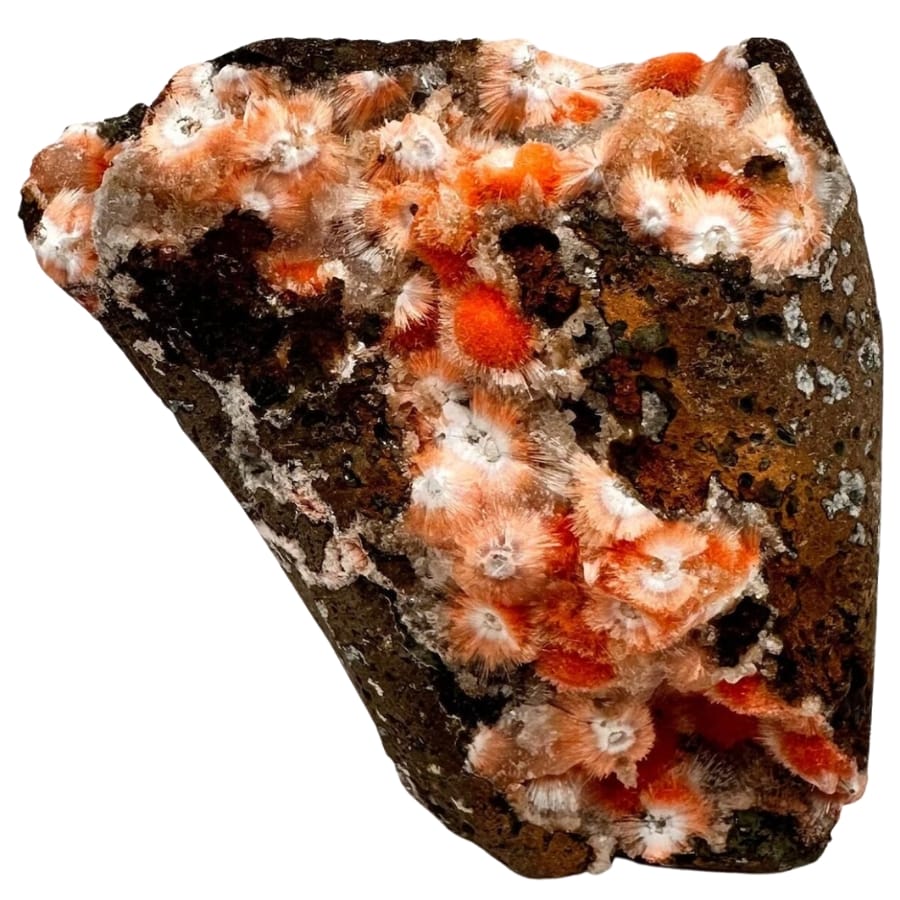
As a member of the zeolites group, thomsonite is a very interesting type of crystal. People know zeolites for the special way they can hold water in their structure. It comes in beautiful round designs and is one of a kind.
It can be white, pink, green, or even orange. It forms in pretty cool ways, mostly in the cracks and spaces in rocks that were made by volcanoes. It starts to grow in the small holes in the rocks over time as water and other elements move through them.
The name “thomsonite” comes from the name of a famous Scottish chemist who studied rocks a lot: Thomas Thomson. Someone who likes minerals will love it because it’s very rare and also looks nice.
Each piece of thomsonite can look like a small work of art because of how the colors and shapes are combined.
Many people still value thomsonite, even though it’s not as well known as some other rocks. Jewelers sometimes use it to make one-of-a-kind, lovely jewelry like chains and earrings.
It’s liked by scientists and teachers as well as people who make jewelry out of it. Thomsonite is used to teach about zeolites and how rocks can form in places where volcanoes happen.
Where you can find Thomsonite in Oregon
Thomsonite can be found in the state in these places:
- Jump-Off Joe Creek
The Gemstones Found Here
Let’s talk about Oregon’s amazing places. Check out our list of our comprehensive articles if you want a full guide:
- Columbia River
Carnelian
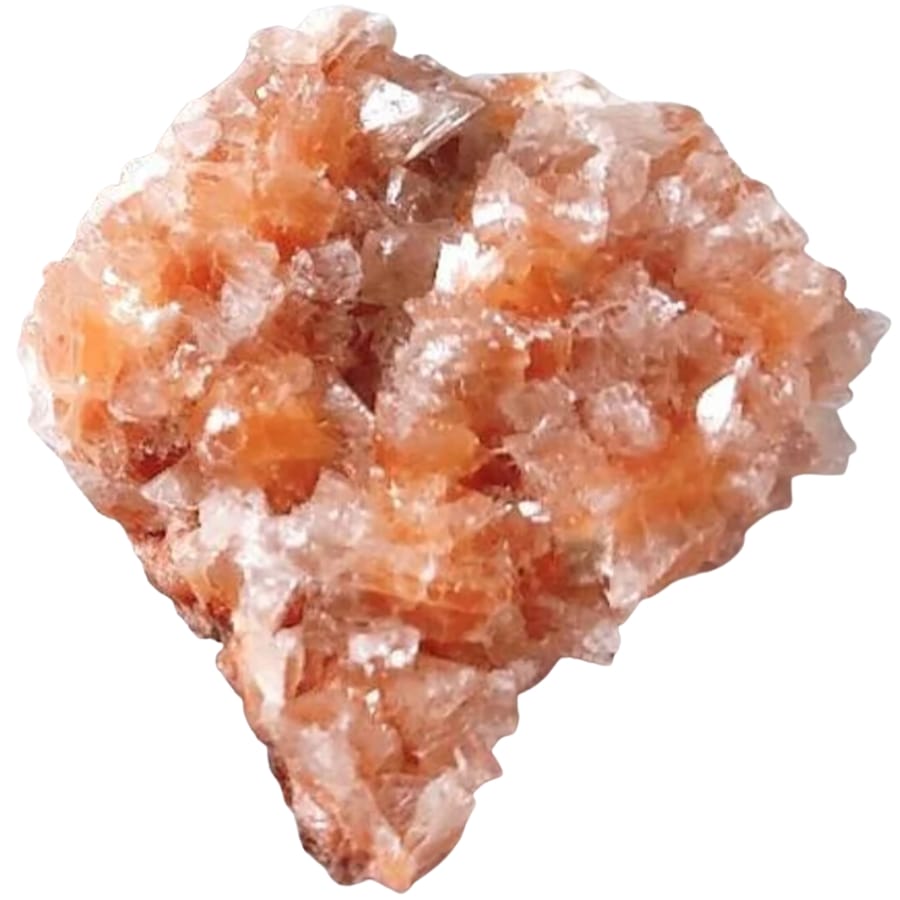
Its warm, reddish-orange color makes carnelian a beautiful and well-known gem. Some kinds of chalcedony are made up of tiny quartz crystals stuck together.
Its unique color comes from iron oxides mixed in with the quartz. It can be a light orange or deep brown color that looks almost red. Usually, it can be found near volcanic rock.
This is because silica-rich water seeps through the rocks, leaving behind the minerals that makeup carnelian.
The name “carnelian” is thought to come from the Latin word “carne,” which means “flesh,” because the stone looks like skin. People have valued this stone for a long time, since ancient times.
It’s beautiful but also pretty tough, making it great for cutting and making jewelry. Carnelian is mostly used to make rings, bracelets, and earrings.
People like it because it has a deep color and shines beautifully when polished. It’s also used to make small carvings and artistic items.
Where you can find Carnelian in Oregon
It can be found in the following places in the state:
- Clear Creek
- Greensprings Mountain
- Nehalem River
- Rogue River
- South Umpqua River
Chrysoprase
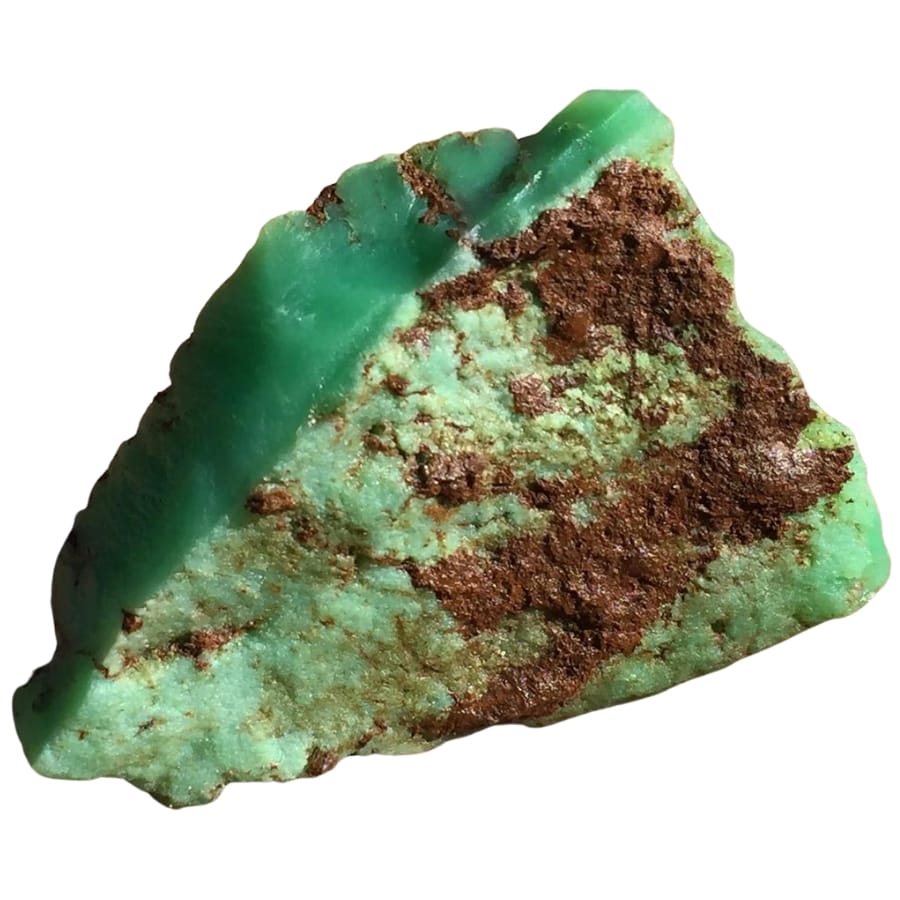
The beautiful green color of chrysoprase makes it stand out as a one-of-a-kind gem. It’s a type of chalcedony, which means it is made up of very small quartz crystals that are clumped together.
Nickel is a metal that mixes with the quartz and gives chrysoprase its green color. It’s not as tough as diamond, but it’s still great for jewelry.
It forms in cracks and holes in rocks, where silica-rich water flows through and leaves behind quartz and nickel, which slowly change into chrysoprase.
Two Greek words, “chrysos” (meaning “gold”) and “prasinon” (meaning “green”), give this stone its name. This is a great name for chrysoprase because of its bright apple-green color, which can sometimes look like green gold.
If it’s a really clear, deep green color, this type of chalcedony is one of the most valuable ones. People have loved this stone for a long time because of its color and beauty.
Chrysoprase is used in many ways, but most of the time it’s made into jewelry like rings, bracelets, and earrings. Designers and gem fans love it because of its beautiful color and strength.
It’s also used to make decorations and sometimes small carvings. In many places, chrysoprase is still a very popular gemstone. People love it for its beauty and the happiness it brings.
Where you can find Chrysoprase in Oregon
Nickel Mountain is one of the best places to find chrysoprase in the state.
Jade
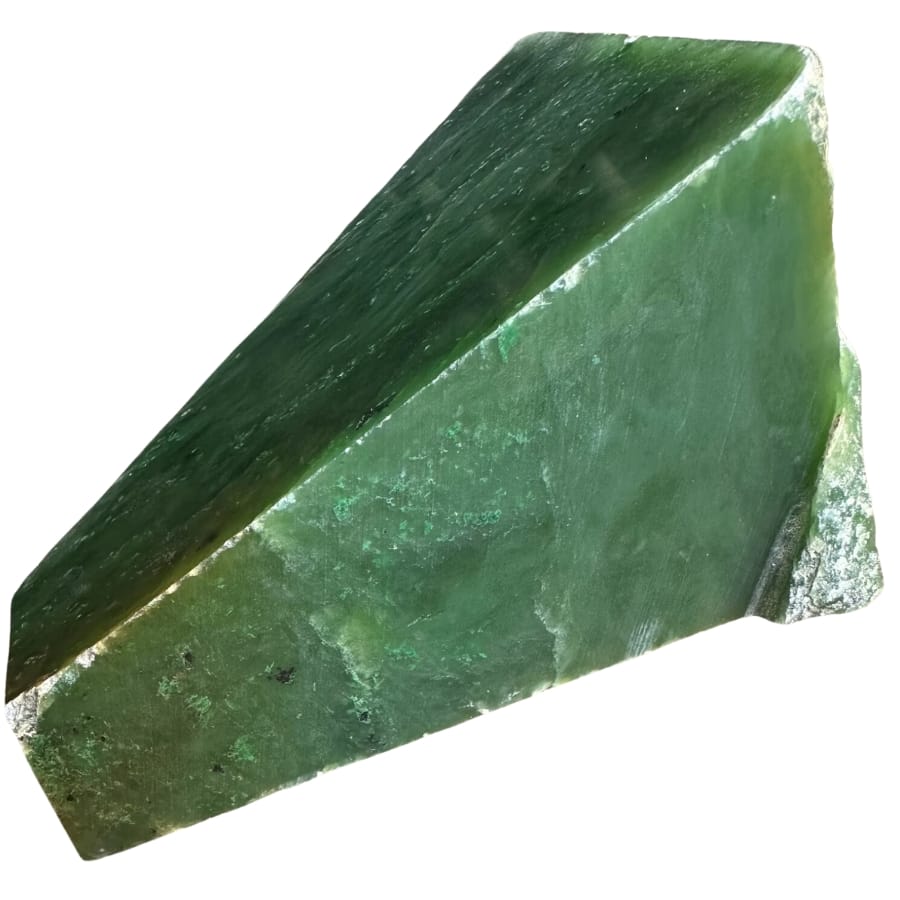
For thousands of years, people have loved jade because it’s a unique and beautiful stone. Nephrite and jadeite are the two types that it comes in. Both types are very tough and come in many colors, but the most well-known is a rich, creamy green.
The Earth’s base has a lot of pressure, but not much heat. This is where jade is formed. Rocks that have changed over time, like metamorphic rocks, are often where it’s found. It can also be found in riverbeds where rocks have been worn down.
There is a Spanish word that means “stone of the side” that is where the name “jade” comes from. People used to think that wearing jade could ease side pain, which is how it got its name.
For a long time, it has been an essential stone in many Asian societies. People respect it not only for how pretty it is but also for how tough it is and how hard it is to carve.
Jade is used for many things these days. A lot of people wear bracelets, earrings, and pendants with it. Beautiful carvings, statues, and other home decor items are made from jade.
In some places, like China, jade is still a sign of wealth and style. Many people value jade because it has a lot of history and meaning. It’s one of the most valuable stones in the world.
Where you can find Jade in Oregon
There are lots of jade reserves in these places:
- Applegate River
- Crow Creek Recreation Area
- Shirttail Creek
- Umpqua River
Moonstone
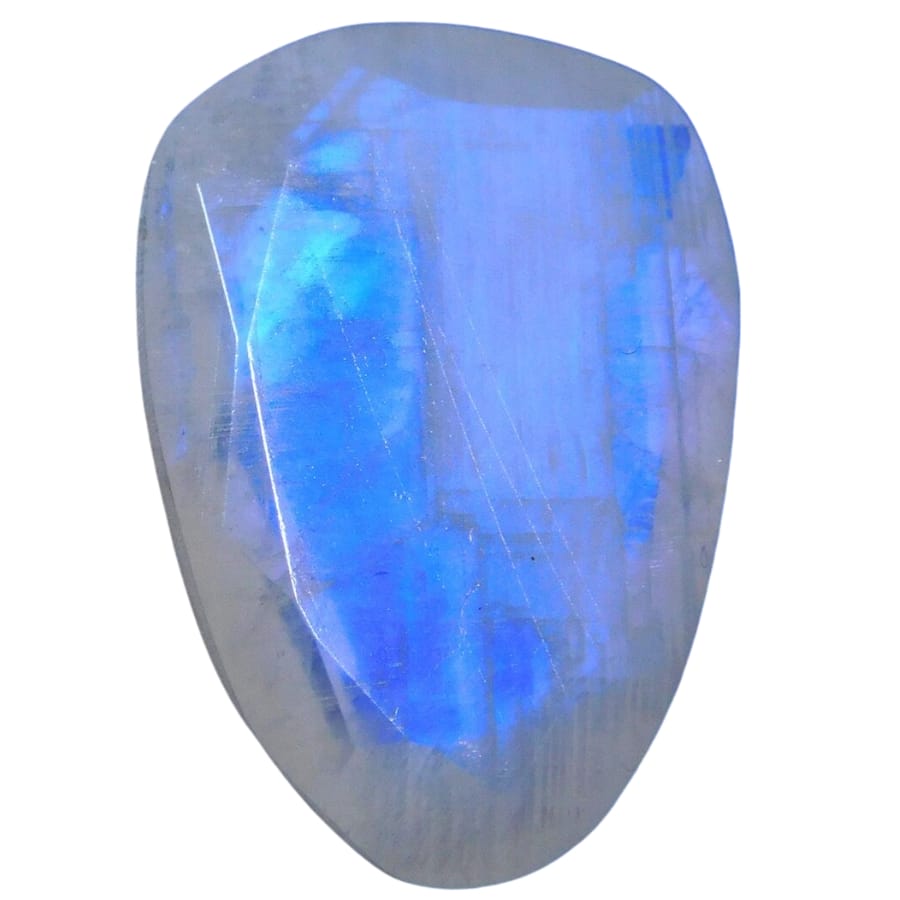
The moonstone is a beautiful gem that looks almost magical. The glow changes as you move it around, giving it its name. This glow is similar to how the moon looks different when clouds pass over it.
Adularescence is the name for this glow. It happens because the stone is made up of layers of feldspar rocks.
It’s found in igneous rocks, formed when lava or magma cooled down. The layers inside the moonstone spread light, giving it a dreamy, glowing look.
This gem is called a “moonstone” because it looks like the moonlight and is mysterious and beautiful. Moonstone has been valued for a long time, mostly because it looks different.
As of now, moonstone is mainly used to make ornaments. Many use it to make earrings, chains, rings, and bracelets. It’s unique and stands out because its colors glow and change.
Moonstone is still a rock that people love, whether it’s because of its gorgeous look or its mysterious aura.
Where you can find Moonstone in Oregon
You can find moonstone in the following places across the state:
- Agate Beach
- Commings Creek
- Ocean Lake
Opal
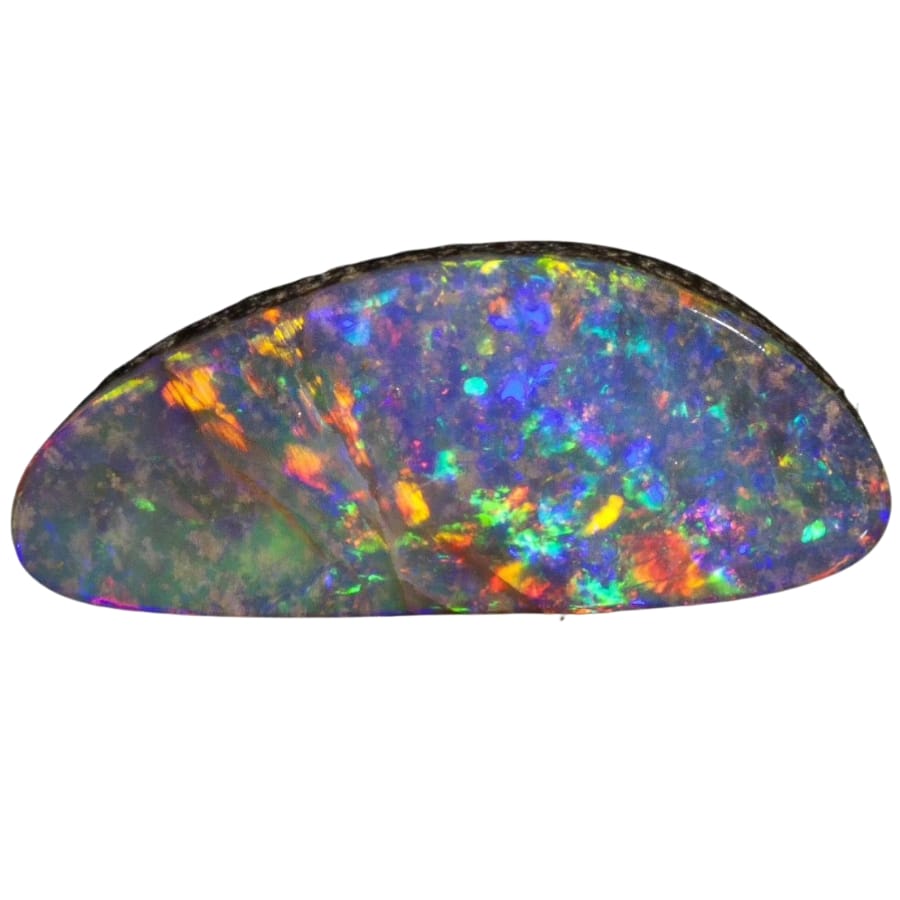
The amazing way the colors change in opal is what makes it so interesting and beautiful. Opals have a pattern made of very small water and silica particles that make this happen.
The word “opal” comes from the Greek word “opallios,” which means “to become different colors.” This is a great name for this mineral because of the way its colors change when it’s lit.
For a very long time, people have loved opals because they are beautiful and look like they have magic hiding inside them.
Most of the time, it’s used to make jewelry like earrings, rings, and bracelets. It’s loved by artists and jewelry makers because it comes in so many beautiful colors.
Gem lovers gather opals because they are beautiful and hard to find. They are also worn as jewelry. Around the world, people still value opal, whether it’s set in jewelry or just looked at for its beauty.
Where you can find Opal in Oregon
The following places in the state are where you can find opal:
- Fulton Agate Beds
- Hart Mountain
- Juniper Ridge Opal Mine
- Opal Butte
- Priday Agates Bed
Quartz
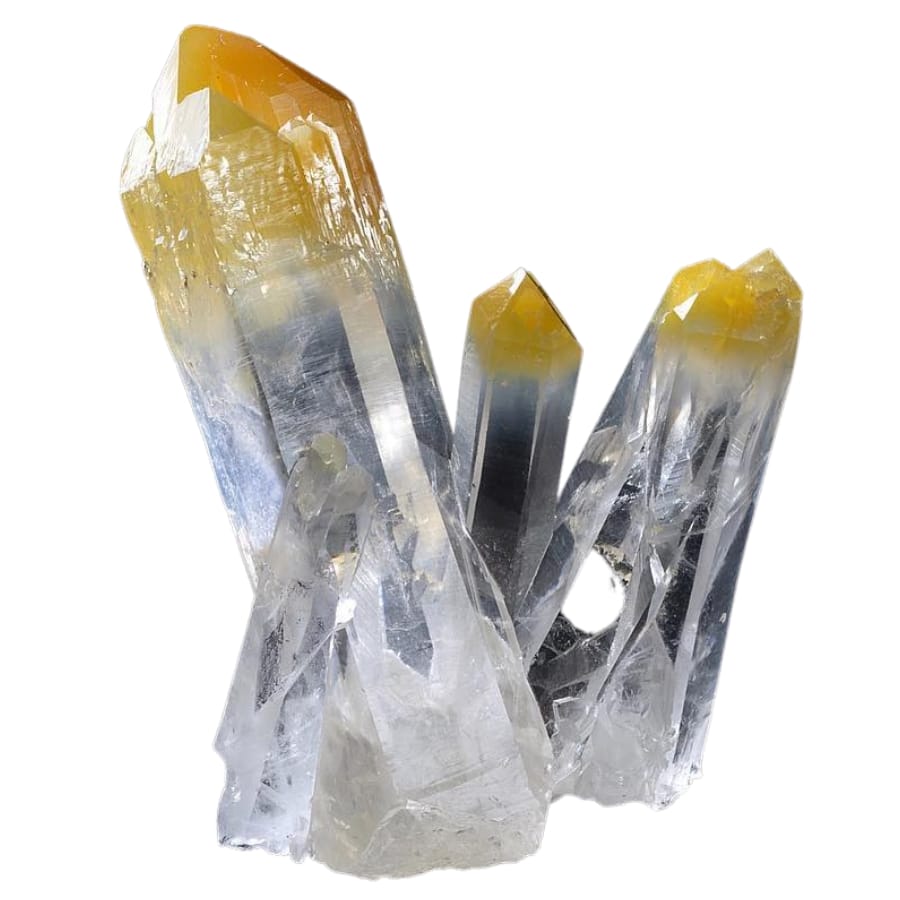
Quartz is a mineral that can be found all over the world and is very famous. Silicon and oxygen, which are found in large amounts in the Earth’s soil, make it up.
It forms in many types of rocks all over the world. As quartz grows, it can be very small or very large. Sometimes it forms big, beautiful crystals that you can see.
Quartz is made when hot water inside the Earth cools down and the silicon and oxygen in the water turn into crystals.
“Quartz” comes from the German word “quarz,” but no one knows where it originated. It’s easy to find and pretty, so people have used quartz for a long time.
Hardness is one of the coolest things about quartz. It’s very tough, which makes it great for many things. In addition, it can carry an electric charge, which is very useful in technology.
Quartz is used for many things. It’s often used to make necklaces and bands because it looks nice and lasts long. Because it helps keep time so well, it’s also used in watches and clocks.
It’s even present in glass and some kinds of countertops you use daily. Some people use quartz for spiritual purposes because they believe it has healing powers. Quartz is a cool material that is used in a lot of cool things around the house.
Where you can find Quartz in Oregon
You can find quartz in the following states:
- Bear Creek Stream
- Harney Valley
- Mount Pisgah Arboretum
- Quartzville Creek
- Table Rock
Rhodonite
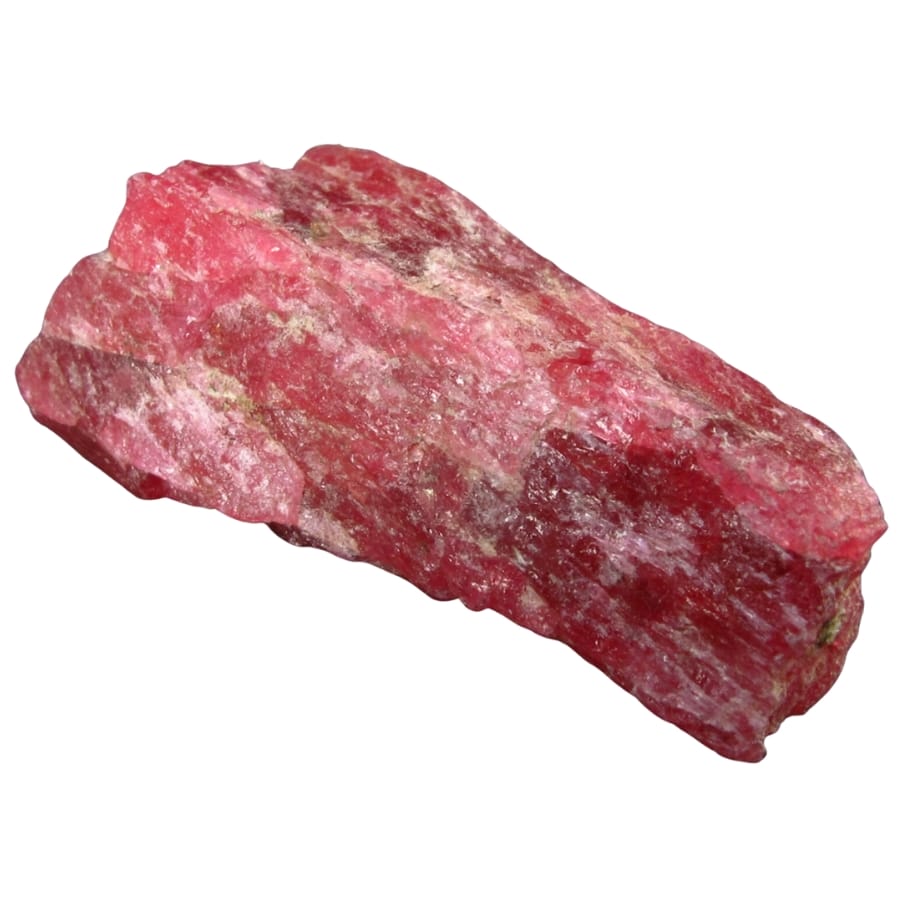
Rhodonite is a pretty cool gemstone that is a deep pink or rose-red. It comprises manganese, oxygen, and other things that can change its color, such as calcium, magnesium, and iron.
Most of the time, it’s found in metamorphic rocks. These rocks have been changed by heat and pressure inside the Earth. It’s sometimes found in these rocks’ small lines or cracks.
Rhodonite often has neat black or gray lines of a different mineral called manganese oxide. These lines make pretty patterns.
It gets its name from the Greek word for rose, “rhodon.” People have loved this gemstone for a long time, both for its beauty and because it has manganese in it, which is used to make some metals.
Because it’s tough and shines up well, it’s often used to make jewelry and home art. Gem collectors and gem lovers really like it because of its unique color and designs.
This stone is the national stone of Russia and has been used in many ancient and important buildings.
Where you can find Rhodonite in Oregon
These places in the state have rhodonite minerals:
- Cave Creek
- Oregon Creek
Turquoise
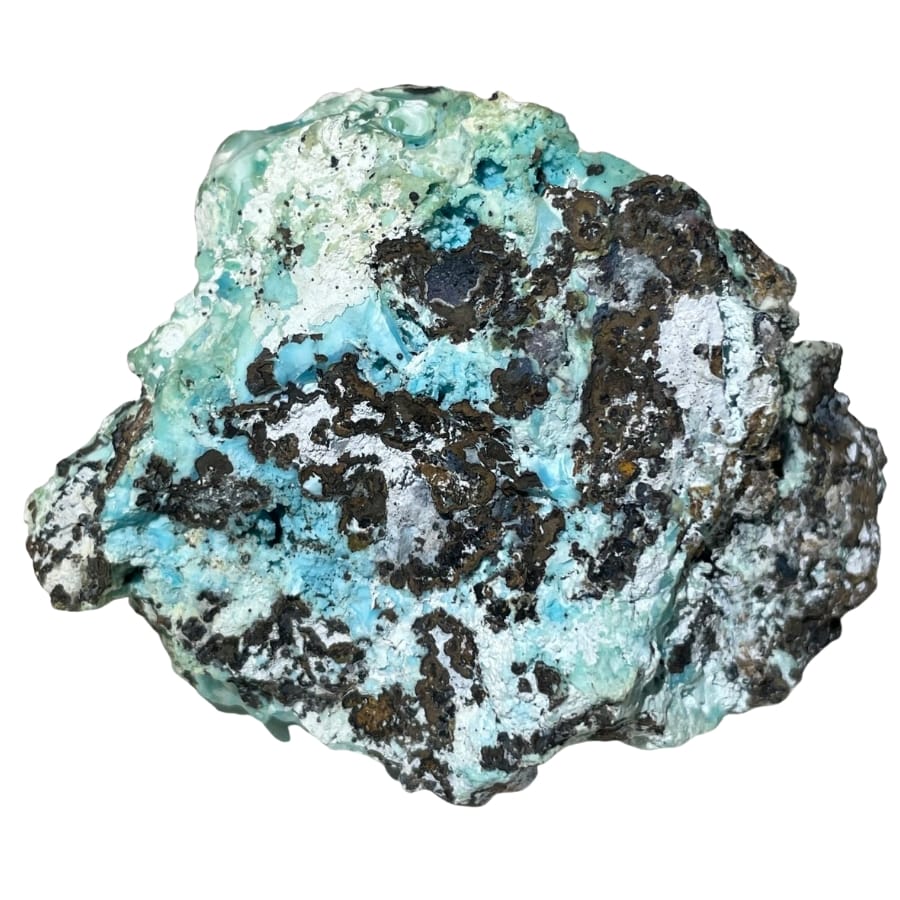
People love turquoise because it’s a very pretty and unique stone in bright blue to green colors. Copper, aluminum, and phosphorus are all used to make it.
Its blue color comes mostly from the copper. Rainwater seeps through the ground in dry places and mixes with copper minerals to make turquoise. This process takes millions of years and doesn’t happen often, making it unique.
You can often find it in the gaps and cracks of rocks, where its bright blue color stands out against the dull rock.
From a French word that means “Turkish stone,” the name “turquoise” comes. This is because the stone was first brought to Europe from Turkey. For a very long time, people have valued, loved, and respected turquoise.
People in the past, like the Egyptians and Native Americans, used it to make art and jewelry. It’s costly because it’s not only pretty but also very rare and hard to find.
These days, turquoise is mostly used to make earrings, bracelets, and rings. Because of its unique color, it’s used for many different styles. Some tribes still use turquoise in ceremonies and as a sign of wealth.
Where you can find Turquoise in Oregon
You can find a lot of turquoise at Columbia River.
The Crystals Found Here
This state has a lot of various crystals and gems that enthusiasts and collectors will enjoy. You can also find crystals in Oregon by reading our in-depth article:
Agate
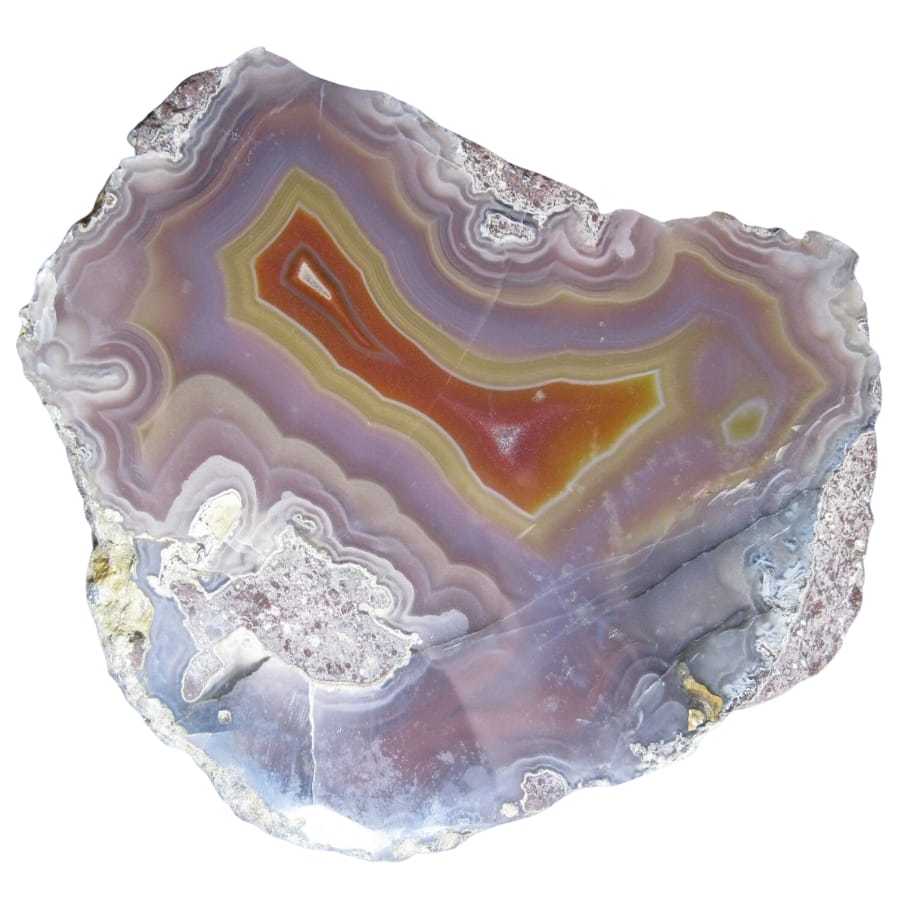
Agate is a super cool and pretty rock that is actually a type of quartz. Amazing shapes and colors are what make it stand out. Colors like red, blue, brown, and green are common, and it often has stripes, waves, or spots.
Agates have their own special way of sticking together. They usually grow in rock cavities that aren’t being used, like bubbles in volcanic rocks or holes in other ones.
The water carries various minerals as it runs through these rocks. In these areas, these minerals build up over time, forming agates.
The name “agate” comes from a Greek word for a stone found in a Sicilian river. Ganeshas have been used and valued for a very long time. Their beautiful patterns inspired ancient people to use them to make jewelry and other home art.
They’re attractive, but they are also strong and long-lasting, which makes them great for many craft projects.
People still love agates for many of the same reasons. A lot of jewelry, like necklaces and bands, uses them. As a decoration, they’re often used to make bookends or slices that you can put next to a window to see the colors come through.
Where you can find Agate in Oregon
Here are some places in Oregon where you can find agate:
- Clear Creek
- Crater Lake National Park
- Klamath River
- Ochoco National Forest
- Willow Creek Reservoir
Azurite
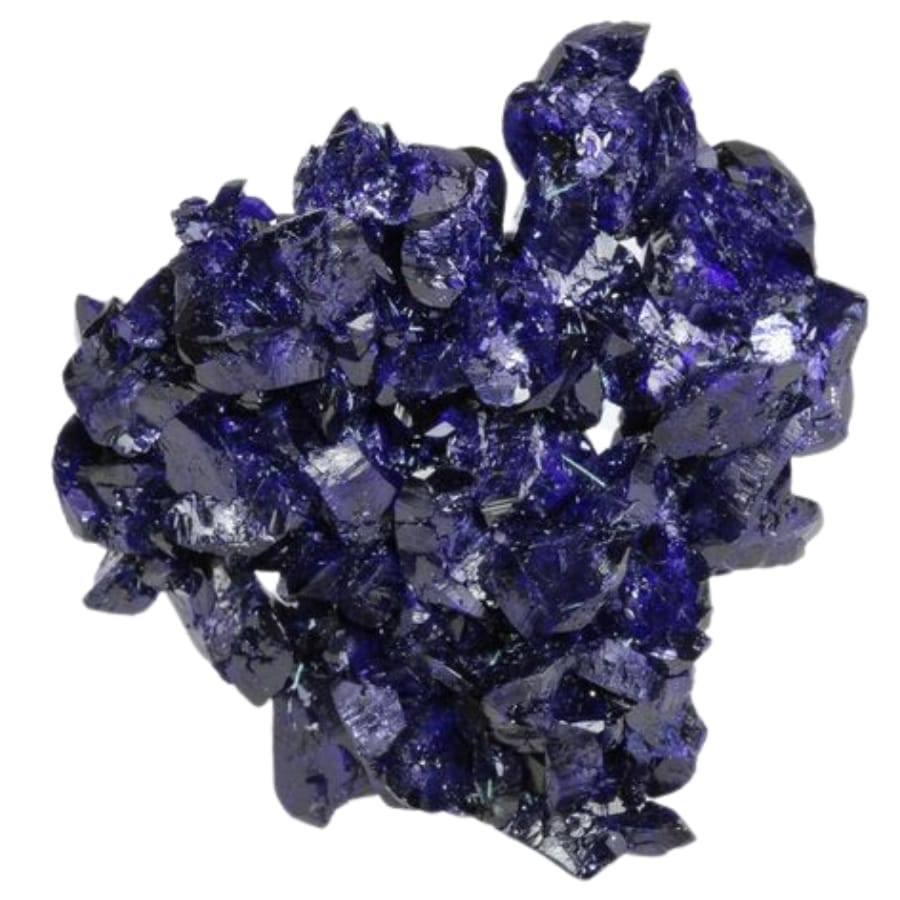
Azurite is a beautiful blue gemstone with a deep, bright color that really stands out. The cool blue color comes from the copper that makes it up most of the time. The way azurite forms is very different from other stones.
It’s generally found where rocks high in copper have been worn down by oxygen and weather, like in copper mines or near copper deposits. It takes time for azurite to form when water meets with copper in rock.
Azurite is sometimes found with malachite, a green copper crystal. The two stones look beautiful together, as they are both blue and green.
Its name comes from the old Persian word “lazhward,” which means “blue.” It makes sense since it’s one of the bluest rocks. It has been valuable for a long time, both for its beauty and for the copper it contains.
It was ground up and used as a blue colorant in paints and dyes. Many people used it to make bright blue colors for art and home decor.
These days, azurite is mostly used for decoration and collecting. People who like minerals and people who make jewelry love its bright blue color.
Where you can find Azurite in Oregon
Azurite is found in large amounts in Oregon, especially in the following places:
- Cedar Springs Mountain
- Illinois River
- Jump-Off Joe Creek
Bloodstone
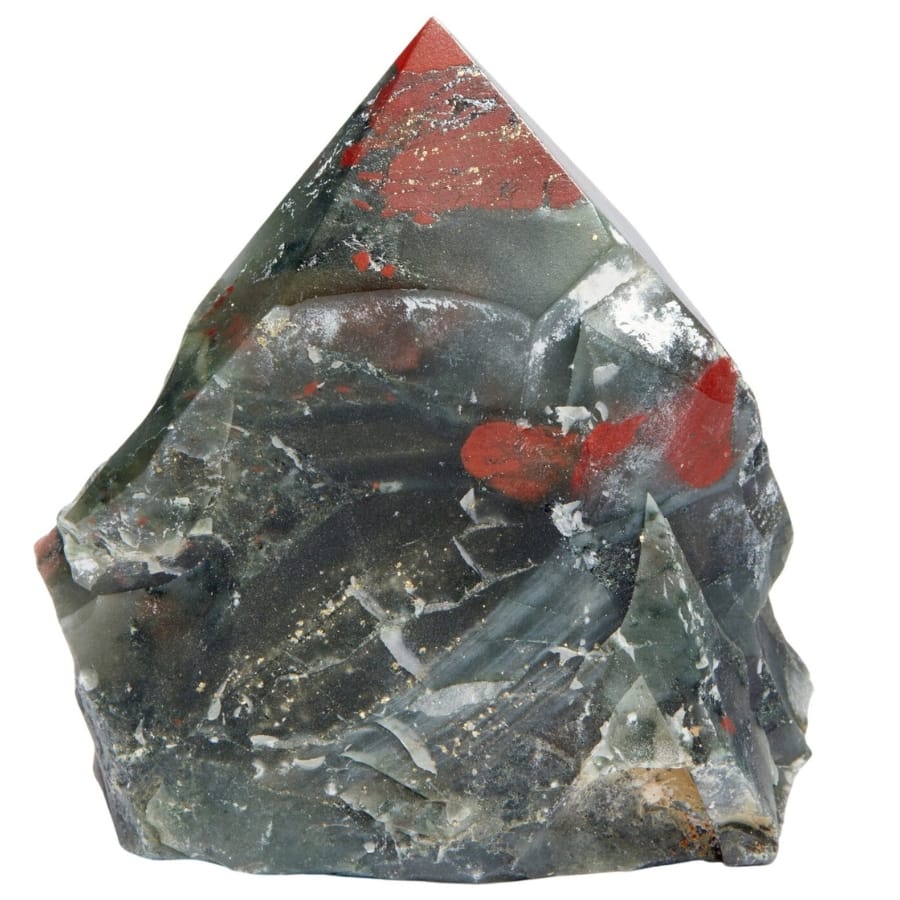
Bloodstone, sometimes called heliotrope, is a fascinating stone with a long past. Crystalline chalcedony is a type of quartz generally dark green with red spots.
It gets its name from the red spots on the stone, which are made of a mineral called iron oxide. They look like blood drops!
If mineral-filled liquid gets into cracks and spaces in rocks, it can turn into bloodstone. The red spots on this liquid stay the same as it forms into bloodstone over time.
The history of the name “bloodstone” is a bit dramatic. People in the past thought that the red spots were Jesus Christ’s blood that fell to the green land and turned into this stone.
It was a very holy and important gem for a long time because of this story. Bloodstone is valuable for more than just its history and interesting look.
It’s also tough and can be polished to a nice shine, which makes it great for jewelry and home decor.
Today, bloodstone is mostly used to make jewelry, seals, and hanging charms. Many people like bloodstone because of how it looks, but some also think it can heal. For example, they believe it can help calm, ground, and even clean the blood.
It’s still admired for its unique beauty and interesting past, whether it’s kept as a special stone or worn as jewelry.
Where you can find Bloodstone in Oregon
Oregon has a lot of bloodstone minerals, especially in these places:
- Big Falls
- Butte Falls
- Ocean Lake
- Table Rock
Galena
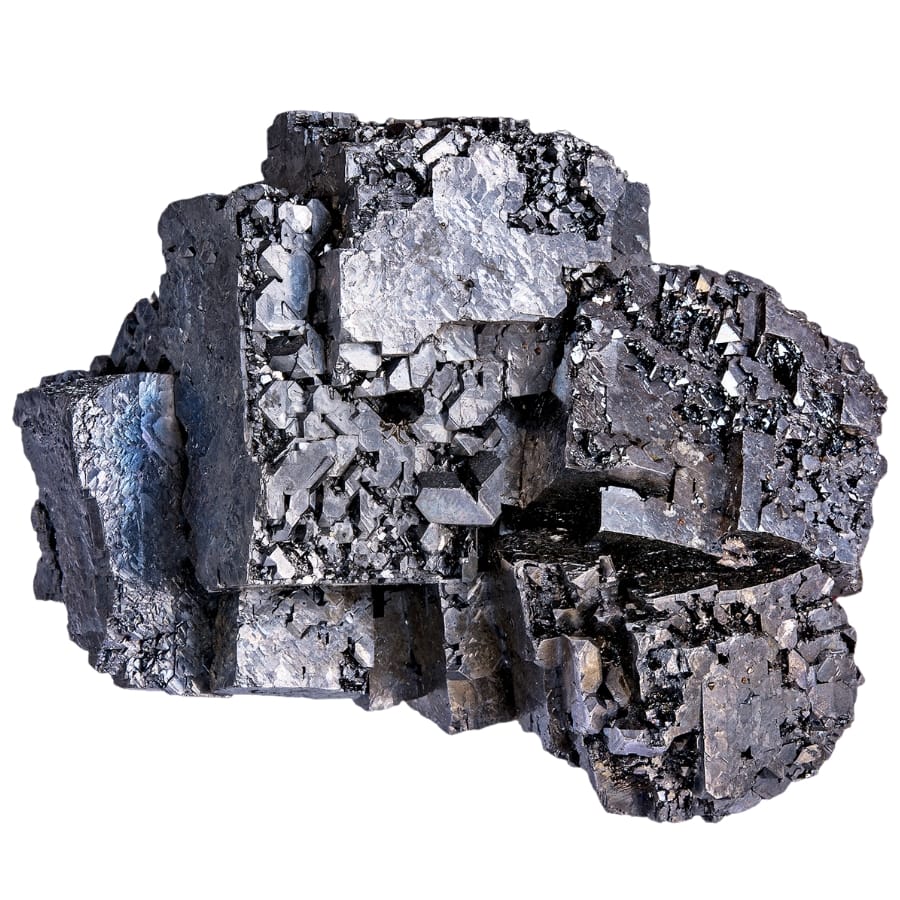
Galena is an interesting material that is mostly made up of sulfur and lead. It looks like metal and is generally gray or silver. It’s pretty heavy for its size, and it often shapes itself into cool cubes and squares.
It can be found in many places worldwide, usually deep underground, where hot fluids from volcanoes are present. These hot liquids move the sulfur and lead into cracks and holes in rocks, where they cool down and change into galena.
Latin words that mean “lead” are where the name “galena” comes from. It makes sense since galena is the main source of lead. Lead has been around for a long time and used in many ways, such as in batteries, bullets, and even to block X-rays.
Galena is also important because it often has silver in it. This silver can be used for many things, such as making coins and jewelry.
Lead isn’t used as often because it can be dangerous, but mineral fans still like galena because of its cool crystal shapes and shiny look.
It’s also used to teach geology and mining because it shows how lead and other metals can be found in the real world.
It’s a cool and important material in geology, but we need to be careful when we handle and use it because it contains lead.
Where you can find Galena in Oregon
There are several galena rocks in Oregon, especially in the following places:
- Illinois River
- Jump-Off Joe Creek
Malachite
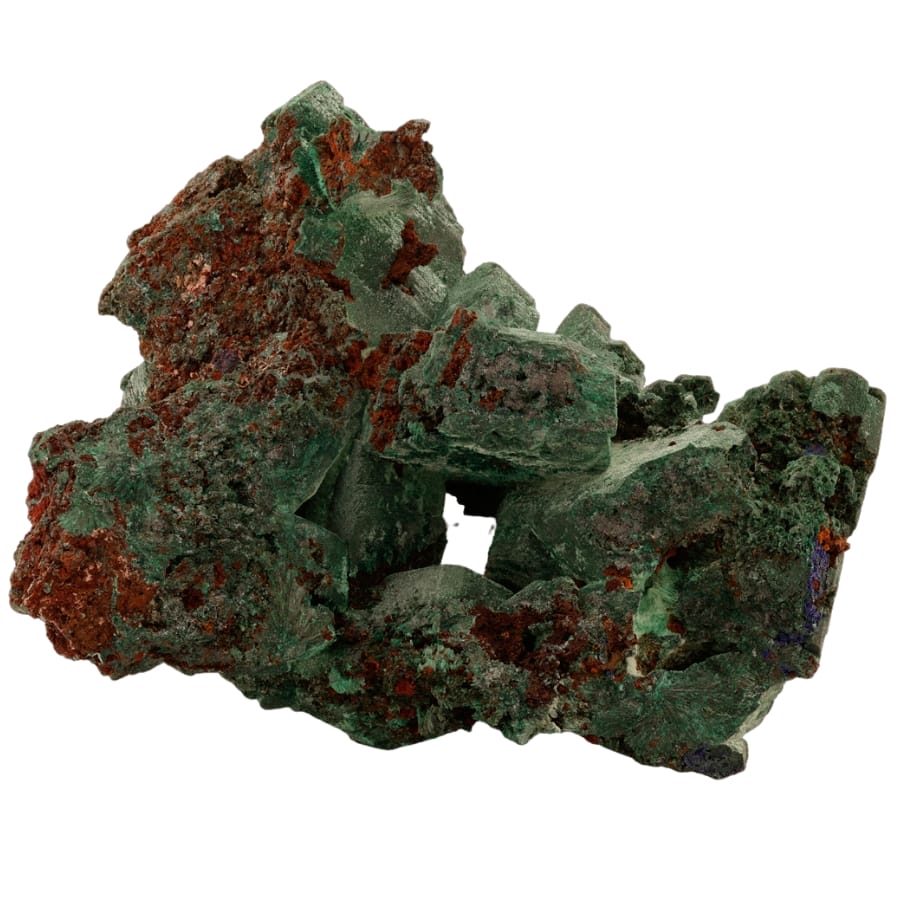
Malachite is a beautiful and rare gemstone that makes things look interesting with its bright green color. Copper carbonate, which is copper, carbon, and oxygen, is what it’s made of.
All of these things work together to give malachite its bright green colors. It’s pretty cool how malachite appears. It generally grows at the top of copper deposits, where the copper minerals mix with oxygen and carbonated water.
This is how the swirling designs and bands of different shades of green in malachite are made.
Its color is like the leaves of the mallow plant, where the name “malachite” comes from:’molochitis,’ which means “mallow-green stone.” For a very long time, people have valued malachite, both for its beauty and because it contains copper.
People in Egypt and other places used malachite to make green paint colors and even to make their eyes look better. It’s often used for jewelry and home art because of its unique green color and patterns.
Jewelry like necklaces, bands, and earrings are mostly made from malachite. It stands out because of its bright green color and interesting designs.
It’s also used to make sculptures, vases, and other artistic items and for the inlay work on furniture.
Where you can find Malachite in Oregon
You can easily find malachite in the state, especially in these places:
- Illinois River
- Mount Pisgah Arboretum
Mesolite
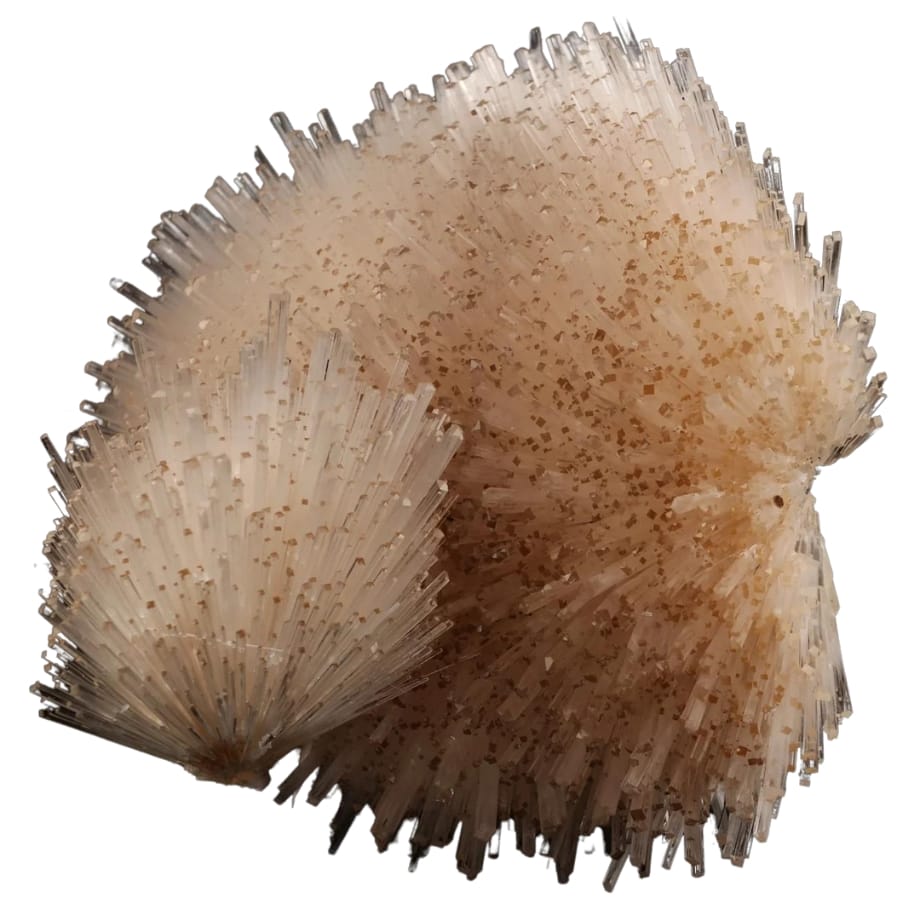
Mesolite is a fascinating and not very common crystal in the zeolite group. There is water in the framework of zeolites, which are minerals. It stands out because its crystals are very small and needle-like.
The crystals are usually white or colorless. Salt, calcium, aluminum, silicon, and oxygen make it up. It normally forms in the cracks of volcanic rocks.
Water that is hot and full of minerals flows through these rocks. As the water disappears, it leaves the minerals forming mesolite crystals behind.
“Mesolite” comes from the Greek words “mesos,” which means “middle,” and “lithos,” which means “stone.” Given this name, it’s situated in the middle of other zeolite materials chemically speaking.
Mineral owners mostly like it because of its unique and delicate crystal structures. When they grow in big, bushy groups, these needle-like crystals can be very beautiful.
It’s a very fragile mineral that isn’t often used in jewelry, but it’s still an important one for science and teaching. Geologists and mineralogists study it to learn more about how zeolites are made and their purpose.
Sometimes, zeolites like mesolite are also looked at for possible uses in things like cleaning water, since they can hold water and other molecules inside their structure.
So, mesolite is an interesting and important mineral in geology, even if it’s not as well known as some other minerals.
Where you can find Mesolite in Oregon
Mesolite can be found in the following parts of the state:
- Mount Pisgah
The Most Valuable Rocks and Minerals You Can Find
Now let’s talk about the most important rocks in the state. It will be worth the hunt if you can find these rocks and minerals.
Oregonite
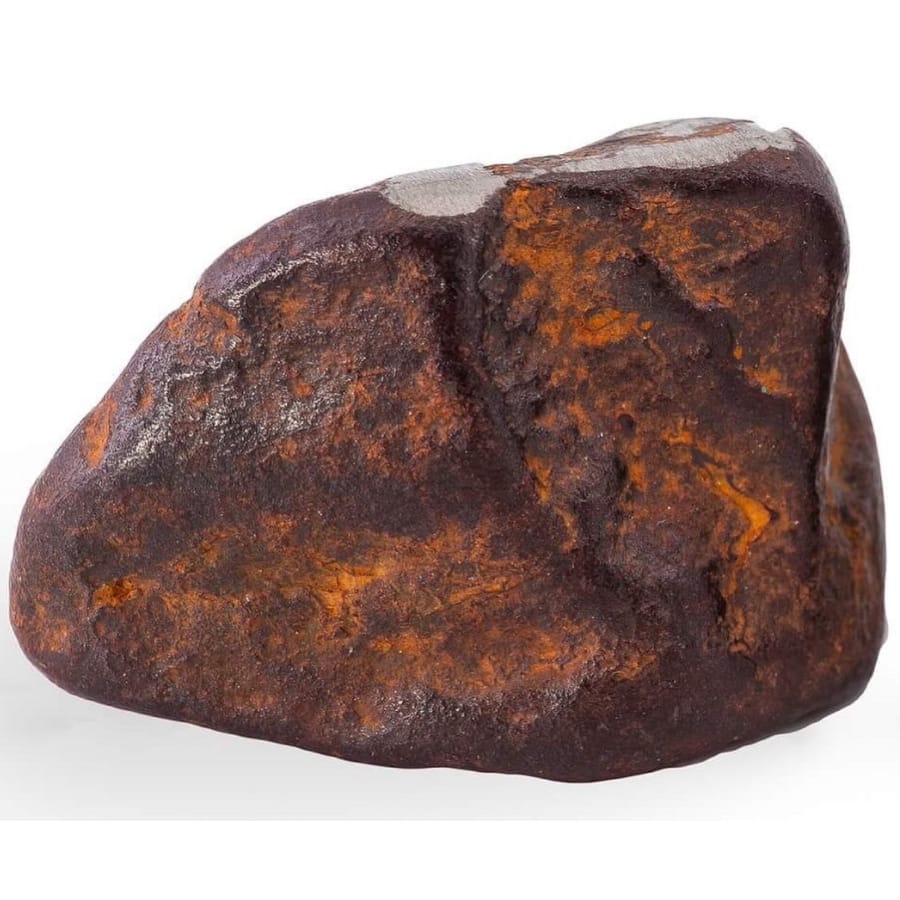
As you might guess, Oregonite is a pretty unique and rare crystal that is mostly found in the state of Oregon. It’s mostly iron, nickel, with small amounts of chromium and cobalt.
Sometimes it’s black or gray glossy, and it looks shiny and metallic. Oregonite is interesting because it comes from serpentinite, a type of rock that grows deep in the Earth’s crust.
It takes a long time for these rocks to rise to the top. If you mix serpentinite with water, it can change and sometimes make rocks like oregonite.
It was first found in Oregon, where the name “oregonite” comes from. A geologist first wrote about this material in the late 20th century, so it’s not very old.
Scientists and crystal collectors are the main people who value Oregonite because it is rare and only found in one place.
They learn more about the Earth’s crust and the processes that make different rocks and minerals when they find minerals like oregonite.
Because it’s so rare, Oregonite isn’t used for useful things like jewelry or industry very often. Geologists who are interested in how rocks form and change study it.
Mineral hunters get excited when they come across a piece of Oregonite because they don’t see it very often. That’s just a small but interesting part of the huge and interesting world of rocks.
Where you can find Oregonite in Oregon
The Josephine Creek district is part of the famous “Josephine Ophiolite,” an area where the Earth’s mantle and oceanic crust have been exposed at the surface due to tectonic activity. Oregonite is found in association with serpentinite rocks in this region.
Oregon Sunstone
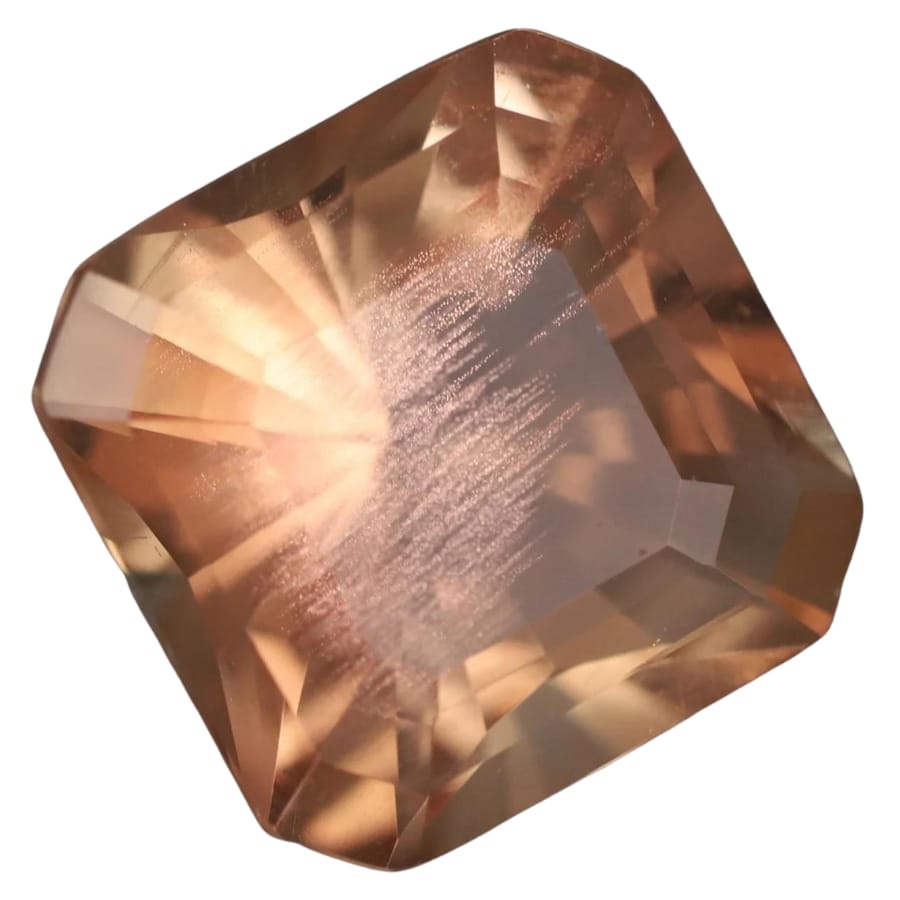
The Oregon sunstone is a beautiful and rare gem found only in Oregon, USA. There are different kinds of this material called feldspar, and it can be clear or yellow, pink, red, or green, and it sparkles and glitters.
It looks sparkly because there are tiny copper bits inside the stone. These bits catch light and make the sunstone shine. It forms where hot lava cools down and turns into rock, like near volcanoes.
The name “Oregon sunstone” is pretty clear: it comes from the state of Oregon, where it’s found, and the way it shimmers and sparkles makes it look like the sun.
There are several reasons why this sunstone is valuable. It’s pretty rare because you can only find it in a few places worldwide. Also, because copper is inside the stone, every sunstone is different and has its own design of color and sparkle.
Rings, chains, and earrings are the main things that Oregon sunstone is used for. It has become very popular for making unique, one-of-a-kind ornaments because it is pretty and different.
Sunstones are sometimes used to make jewelry, but some people also gather them as a hobby because they like the way each one is different in color and pattern.
Many people love Oregon sunstone, whether it’s set in a beautiful piece of jewelry or just looked at for its beauty.
Where you can find Oregon Sunstone in Oregon
In Oregon, you can find Oregon Sunstone at the Oregon Sunstone Collection Area.
Thunderegg
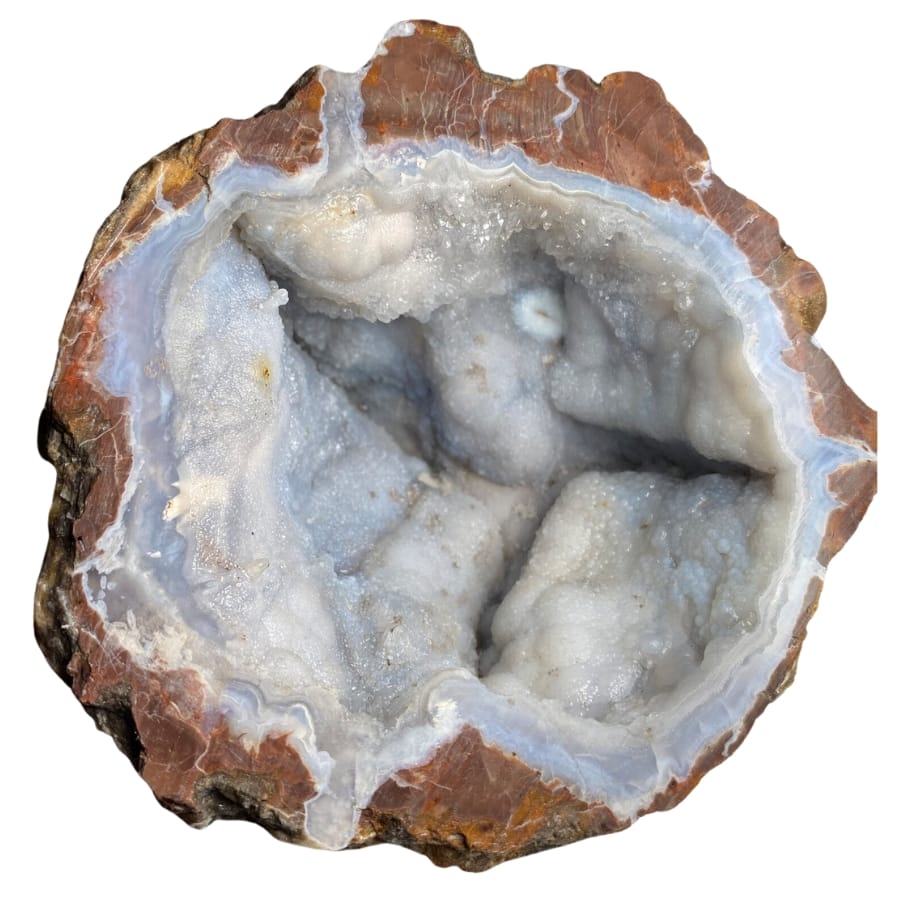
It’s not like most rocks that you see; thundereggs are actually really cool geological forms. Although they look like normal rocks at first glance, cutting them open reveals stunning colors and patterns.
You can find thundereggs near volcanoes, where the lava moves and cools. There are gas bubbles inside the lava as it cools down.
Minerals like agate and quartz seep into these holes over time and harden, making the beautiful patterns inside thundereggs.
The name “thunderegg” comes from a funny place. It comes from a story told by Native Americans. The gods in the mountains are said to have thrown these rocks at each other during storms, which is why they can be found where the “thunder spirits” fought.
So, finding thundereggs is a lot like finding pieces of a story from a long time ago. They’re valuable because each one is different, not just because they look cool. Before you open a thunderegg, the designs and colors inside might surprise you.
People love collecting thundereggs and making things out of them for decoration. They’re the official state rock of Oregon, where they’re very famous. Rock fans cut and polish them to show off the pretty designs inside.
You can also use them to make jewelry, paperweights, and bookends. Finding thundereggs outside can be fun, and it’s always interesting to break them open and see what’s inside.
Thunder Eggs are an interesting part of rock collecting, whether you keep them as a natural treasure or use them to make something pretty.
Where you can find Thundereggs in Oregon
The following places in the state are good places to find thunderegg:
- Lucky Strike Mine
- Succor Creek State Natural Area
- Wheeler High School Fossil Beds
- White Fir Springs
How to Identify The Rocks and Minerals You Find
For many reasons, it is very important to know the difference between rocks and minerals. Nature is beautiful and full of different kinds of things. Geologists use it to learn about the past of a place and find out how important mineral reserves might be.
It can be tough to tell what kind of mineral something is because they look so different. Everything you need to do is watch, know how things are made, have good tools, and sometimes try out new ones.
Gathering basic tools
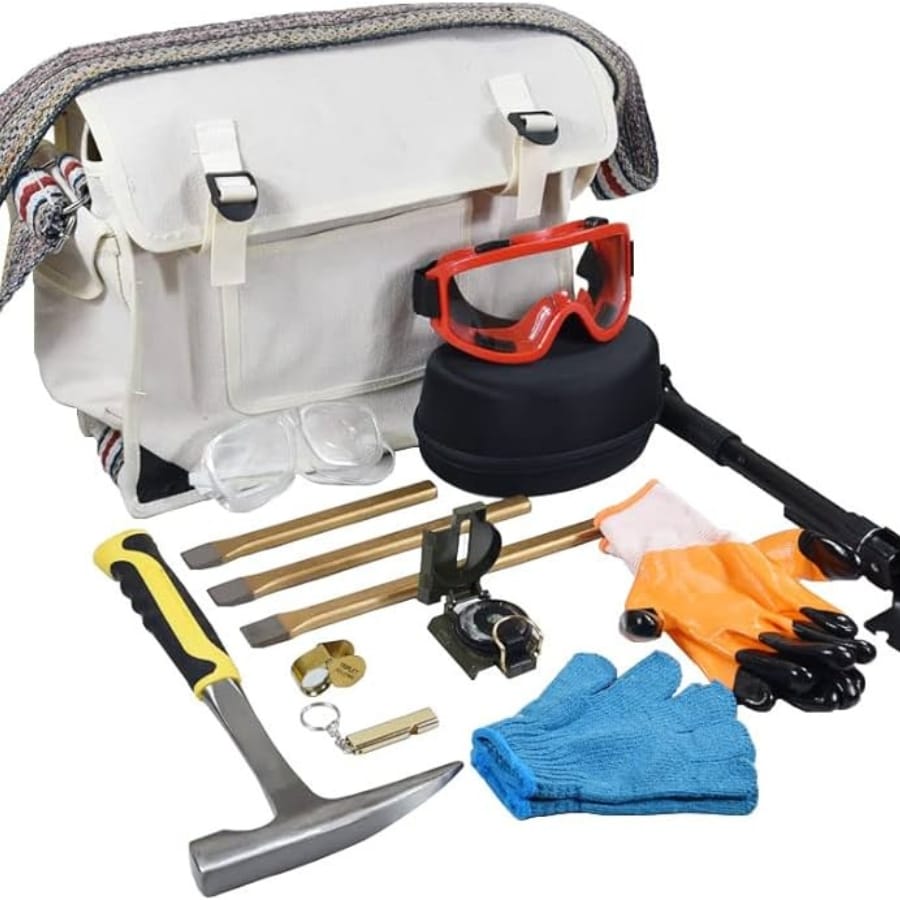
Bringing the right tools and equipment when collecting rocks, gems, and minerals is crucial for several reasons.
First and foremost, collecting rocks can be dangerous without the right gear. Safety glasses or goggles protect your eyes from flying debris when chipping at rocks. Gloves shield your hands from sharp edges and rough surfaces.
A hard hat might be necessary in areas with a risk of falling rocks. Also, sturdy boots ensure good footing on uneven terrain.
Using the proper tools makes the task of collecting much more efficient. For example, a good rock hammer or geologist’s pick is essential for breaking and chipping rocks to extract specimens.
A chisel can help pry rocks from their locations. Without these, you might not be able to collect the samples you want, or you could damage them in the process.
Tools like a magnifying glass or a hand lens are important for closely examining rocks and minerals.
They can help you identify small crystals, fossils, or other features that aren’t visible to the naked eye. Also, having a field guide or mineral identification book can aid in determining what you’ve found.
Observe Physical Properties
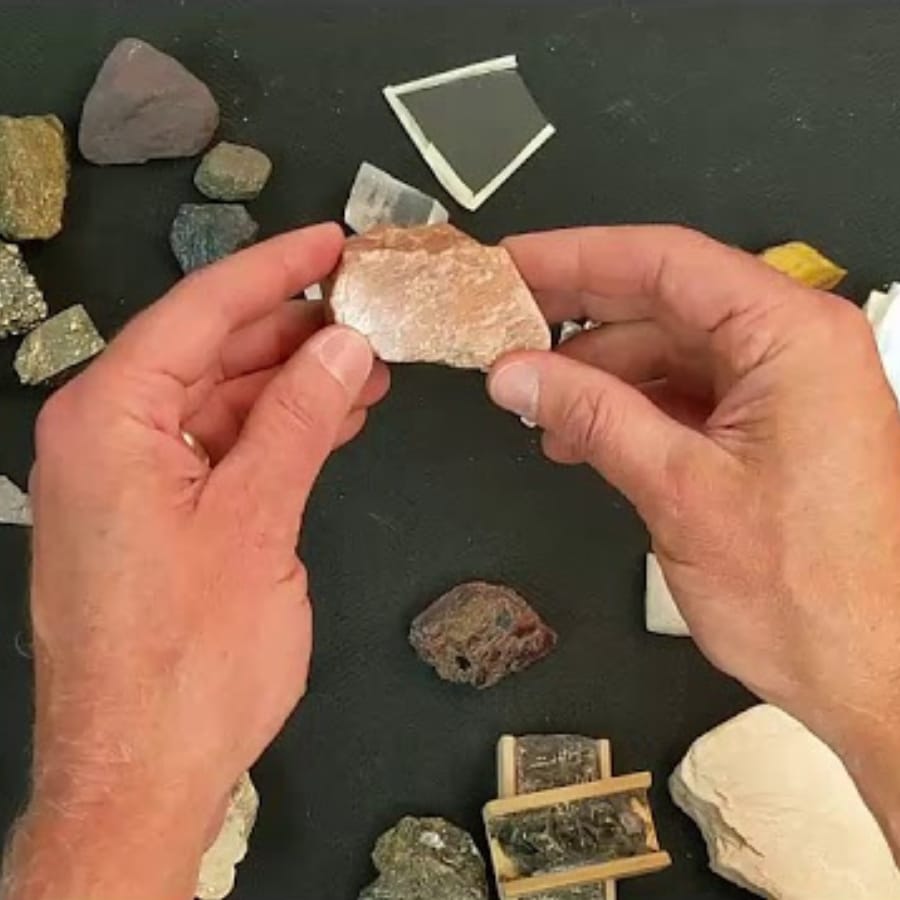
Observing a rock, gem, or mineral properly involves a few key steps, which can help you learn a lot about its properties, origin, and value.
Start by looking at the specimen’s overall shape, size, and color. Notice unique features like layering, banding, crystal structures, or fossil inclusions. Check for luster (how shiny it is) and transparency (whether it’s transparent, translucent, or opaque).
Use a magnifying glass or a hand lens to get a closer look. This can reveal smaller details like grain size, crystal shape, and texture. Observe the color more closely. Some minerals may have different colors on different surfaces, or they may change color under different lighting conditions.
Look for any signs of weathering or alterations, such as cracks, pits, or areas where the mineral has changed color or texture.
Take notes about your observations and tests. This can include color, texture, hardness, luster, and any reactions in the tests.
Perform Hardness Test
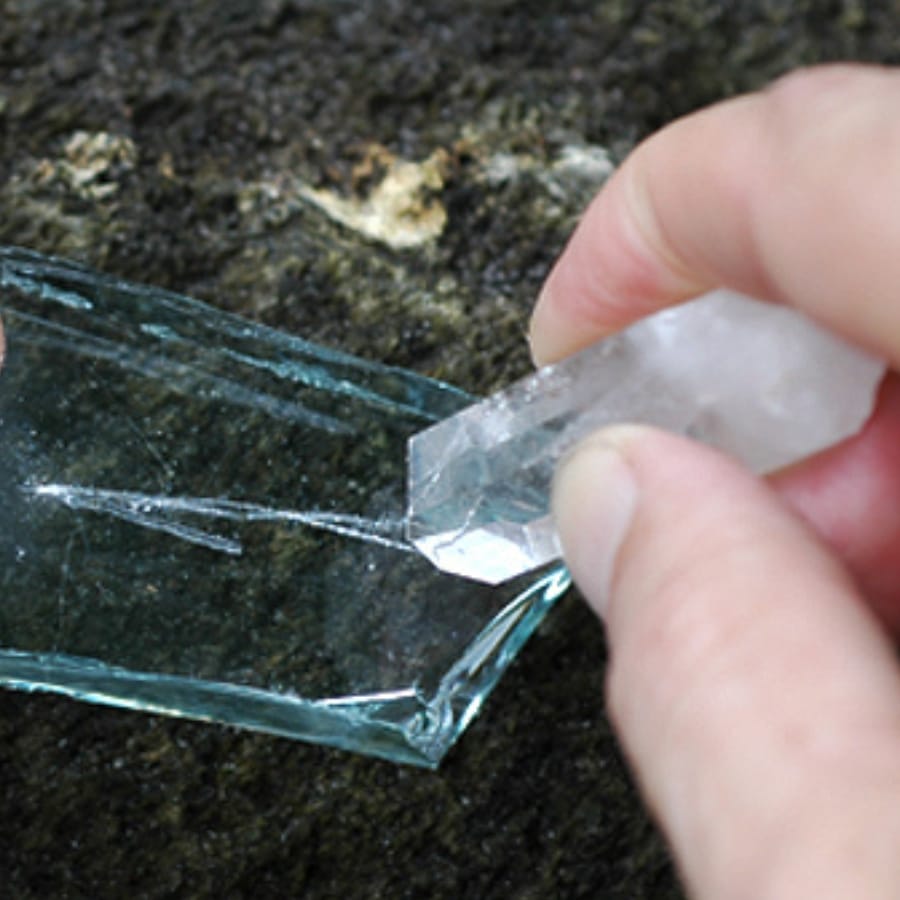
Performing a hardness test on a rock, mineral, or gem is a great way to help identify it, as each mineral has a characteristic hardness.
The most common method for testing hardness is the Mohs scale, which ranks minerals on a scale from 1 (very soft) to 10 (very hard).
Familiarize yourself with the Mohs scale of hardness. Have on hand a set of objects of known hardness, like a fingernail (hardness 2.5), a copper coin (3.5), a knife blade or steel nail (about 5.5), a glass plate (5.5), and a steel file (6.5).
Start with a softer testing material. If it scratches the specimen, try something harder until you find the hardest material that can still scratch your specimen.
A real scratch will be a visible line cut into the specimen. Sometimes a softer material can leave a mark that looks like a scratch but is a streak of material from the softer object. Make sure it’s a genuine scratch.
Take note of the highest hardness level that your specimen can scratch, and the lowest level that can scratch your specimen. This range gives you the hardness of your specimen.
Remember, always conduct the hardness test on an inconspicuous area or on a part of the specimen that’s less important, as this test can damage the specimen.
Determine its specific gravity
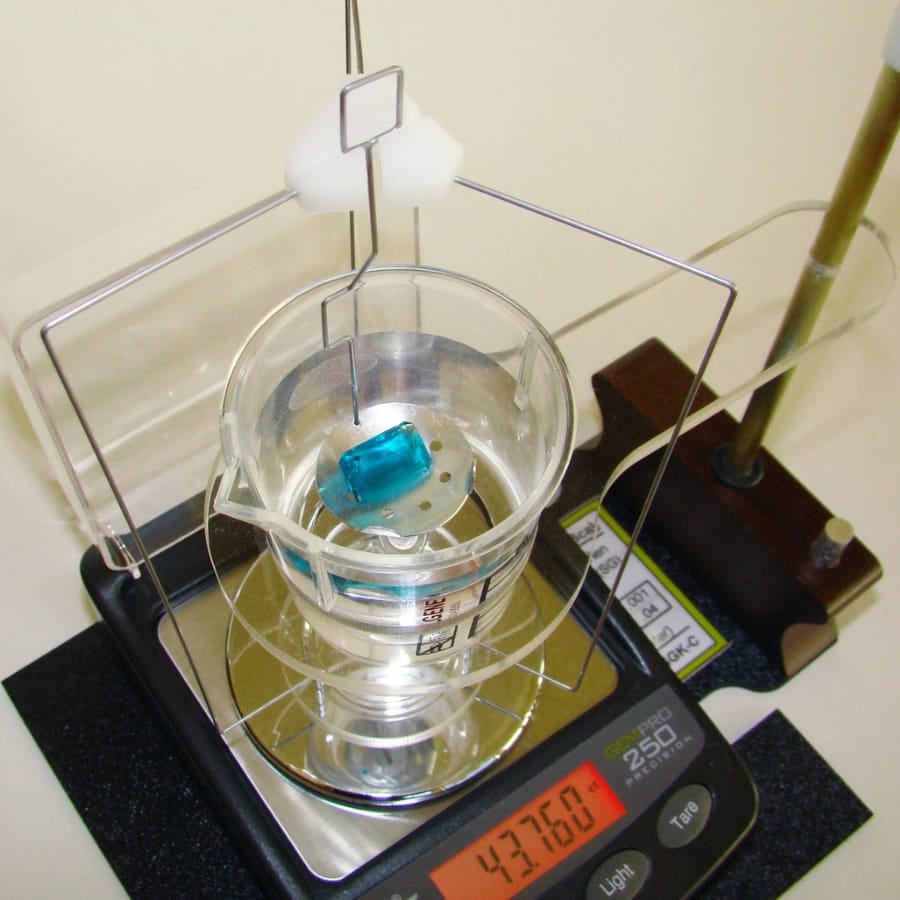
Performing a specific gravity test on a rock, mineral, or gem is a method used to identify it by measuring its density. Specific gravity is the ratio of the density of the mineral to the density of water.
Gather your materials. Use a small, accurate scale that can measure in grams, a cup or container filled with water, a piece of string or thin wire (if the specimen can be suspended), and your rock, mineral, or gem specimen.
First, weigh your specimen in air and record its weight in grams. This is its “dry weight.”
Attach the specimen to the string or wire. Make sure it can be completely submerged without touching the sides or bottom of the container.
Tare (zero out) the scale with the empty container of water on it. Suspend the specimen in the water without letting it touch the sides or bottom of the container. Weigh it while submerged. This is the “wet weight.”
Remember, the accuracy of your results depends on the precision of your scale and measurements. Also, be careful with water-sensitive specimens as they might not be suitable for this test.

